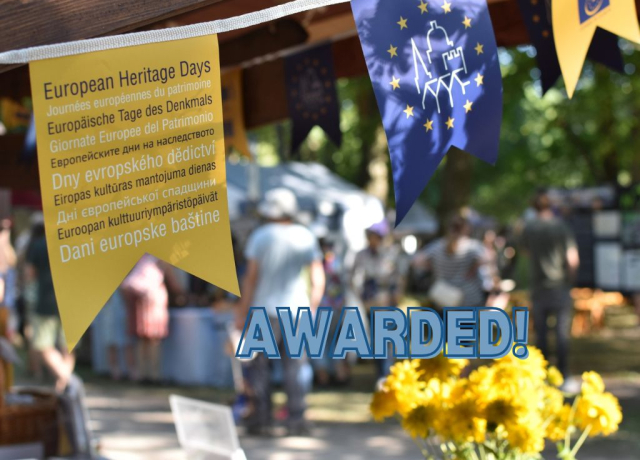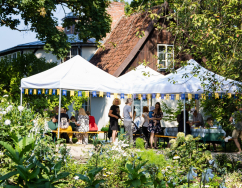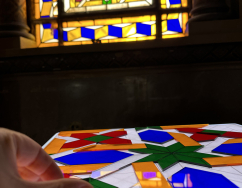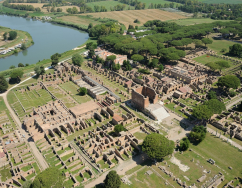European Heritage Days Article:
Eight Projects Awarded Grants through the 2025 European Heritage Days Stories Call
European Heritage Days Article:
Eight Projects Awarded Grants through the 2025 European Heritage Days Stories Call
These projects were selected through the annual Call for European Heritage Days Stories, an initiative that aims to highlight the European dimension of heritage sites and practices, as seen and shaped by communities. By sharing and supporting these stories, the initiative strengthens the shared values of Europe and ensures that heritage remains a vibrant, living part of our collective identity.
The 2025 edition of the call was open from 13 February to 12 March, inviting applications from EHD event organisers.
We are proud to announce the eight selected projects that will receive support this year. Each of them embodies creativity, inclusiveness, and dedication to cultural heritage. Through their local initiatives, these stories reveal broader connections to Europe’s diverse and shared cultural landscape.
Architecture at Touch – Montenegro State Lending Library for the Visually Impaired
In partnership with the Historical Institute of Montenegro, the State Lending Library is creating the first comprehensive architectural lexicon in multiple formats: printed, audio, tactile, and digital, including tactile maps and audio guides.
The project will also host a public event and exhibition involving architects, historians, and members of the disability community. It encourages professional-user collaboration and translates content into English, promoting both accessibility and intercultural understanding. Designed as a lasting educational resource, the materials will benefit schools, museums, libraries, and cultural centres, and serve as a pioneering inclusive heritage interpretation model in Montenegro and beyond.
Art, Culture and Heritage for All – Espaces, Tourisme & Culture asbl
This project aims to make the Abbey of Stavelot a European model of cultural accessibility. It involves installing inclusive physical infrastructure (ramps, lifts, signage, seating), deploying portable mini museums, interactive digital tablets, and producing multilingual visit booklets (including Dutch and easy-read formats), along with guided tours in Belgian Sign Language.
It will also organise training sessions for staff in inclusive mediation, develop heritage edutainment with intercultural and European citizenship themes, and promote social cohesion through shared heritage experiences. The Abbey is being repositioned as a welcoming, inclusive cultural hub for diverse audiences.
Keretsi – Apprenticeship and Hands-on Workshop on Traditional Lime-Based Building Materials – Boulouki
Set in Frasta, Tzoumerka, the Keretsi project revives traditional lime-based building techniques through a five-week training programme and practical workshop in October 2025. It includes a professional apprenticeship focused on mortar repointing and plastering, directly supporting the restoration of a historic school building.
Participants—26 young trainees and two master craftspeople—will gain practical conservation skills and contribute to preserving intangible heritage. It provides a green, sustainable skills model that bridges traditional craftsmanship and modern environmental values.
Railway Heritage of La Encina – Asociación Vecinos La Encina
In a town formed by its 160-year railway legacy, this project builds on past initiatives and the 2023 European Heritage Days event. Centred on conservation, dissemination, and networking, the project includes a participatory inventory of railway moveable heritage, guided by heritage experts, as a foundation for a future local railway museum.
It will also create a railway-themed escape room enriched with oral testimonies and digital content, install interpretive signage with QR codes on historic railway buildings, and establish connections with industrial heritage networks.
Open House Tallinn 2025 – Eesti Arhitektuurikeskus MTÜ
Taking place 11–12 October 2025, Open House Tallinn invites the public to explore around 40 architecturally significant locations—historic, contemporary, and hidden—with the theme “Future Heritage”, reflecting on what future generations will inherit.
The event features guided tours in Estonian, English, Russian, and Estonian Sign Language, lightning lectures, and an expanded volunteer programme with training in guiding, communication, leadership, and heritage interpretation. It aims to deepen public engagement with the built environment, promote inclusive access, and foster dialogue on urban design and sustainability.
Love Oswestry – Memorial Hall Oswestry
Centred around reshaping the cultural architecture of Oswestry, this multi-strand project connects place, people, and programming to make heritage more inclusive and community-driven. Key activities include Heritage Open Days 2025, with street artist Joseph Schneider’s pOSibility Machine, engaging over 500 people in architectural storytelling, and Love Oswestry 2026, a winter festival with art, music, and cultural sharing from new communities such as Bulgarian and Ukrainian residents.
Other strands include the co-creation of a youth-designed heritage trail, an Education Forum to connect schools and heritage groups, and developing better communication and signposting strategies, including two Event Information Hubs. The project culminates in piloting a House of Cultural Heritage model at Memorial Hall, which celebrates its 120th anniversary in 2026 and aims to become a central creative and community hub.
Villa Giustiniani – The Roots of the Mediterranean
This transnational project explores the Mediterranean legacy of the Giustiniani family, originally from Genoa, who played a major political and economic role from the 14th to 16th centuries across Chios, Genoa, and eventually Bassano Romano in Italy. Centred on Villa Giustiniani and its historic frescoes, the initiative uses the family's story as a lens to connect the communities of Bassano Romano, Genoa, and Aghios Minas (Chios), emphasising shared heritage and cultural memory.
The core of the project is a creative collaboration between high school students from the three locations, who will co-create a site-specific work of environmental art to be installed at the villa and mirrored in Genoa and Chios. Guided by educators and curators, students will engage in joint research and creative production, both in person and digitally, culminating in a collective video-documentary titled Diary of Roots. This will serve as both a creative record and an enduring educational resource linking Mediterranean histories across generations.
Voices from the Lake – The Roman Ships and Nemi Museum
This project centres on the extraordinary Roman ships built under Emperor Caligula in the 1st century AD and recovered from Lake Nemi in the 1930s. These luxurious vessels—essentially floating palaces—demonstrated the advanced engineering and artistic excellence of ancient Rome. Their dramatic recovery and tragic destruction in a fire during WWII left a lasting impression on the local community and European archaeology. Today, the Roman Ships Museum of Nemi seeks to reawaken public knowledge of this legacy.
Through academic partnerships, community engagement, and digital storytelling tools, the project aims to reinterpret the historical and cultural meaning of the Nemi ships for modern audiences. It will preserve oral testimonies, promote historical awareness, and connect the ships’ legacy to wider European narratives of innovation, fragility, and resilience. A multilingual podcast and other accessible media will ensure the story is shared across generations and borders.
To explore these inspiring initiatives in greater detail, we invite you to read the full stories. Together, they demonstrate how local actions can illuminate shared European heritage, foster cross-cultural dialogue, and ensure that our collective history remains relevant for future generations.



